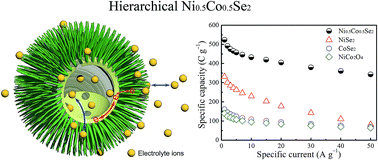Hierarchical hollow, sea-urchin-like and porous Ni0.5Co0.5Se2 as advanced battery material for hybrid supercapacitors†
Abstract
Hierarchical Ni0.5Co0.5Se2 containing a hollow inner structure, with a 3D sea-urchin-like overall morphology and very porous nanowires, was first synthesized by a low-temperature selenization method. Benefiting from such a hierarchical structure, the Ni0.5Co0.5Se2 demonstrates a much improved specific area to provide more electroactive sites and a self-supporting 3D structure to make good contact with the electrolyte. More significantly, it is found that the bimetal Ni0.5Co0.5Se2 combines electrochemical advantages from both Ni and Co, showing high electroactivity and low charge transfer resistance. As a result, the hierarchical Ni0.5Co0.5Se2 exhibits a higher specific capacity of 524 C g−1 at 1 A g−1, a superior rate performance of 56% capacity retention when the specific current increases by 50 times and excellent cycling stability of 91% capacity retention after 3500 cycles. In addition, an Ni0.5Co0.5Se2//reduced graphene oxide (RGO) HSC achieves a high specific energy of 37.5 W h kg−1, an ultrahigh specific power of 22.2 kW kg−1 and an outstanding cycling stability up to 10 000 cycles, further confirming the superior performance of hierarchical Ni0.5Co0.5Se2.



 Please wait while we load your content...
Please wait while we load your content...